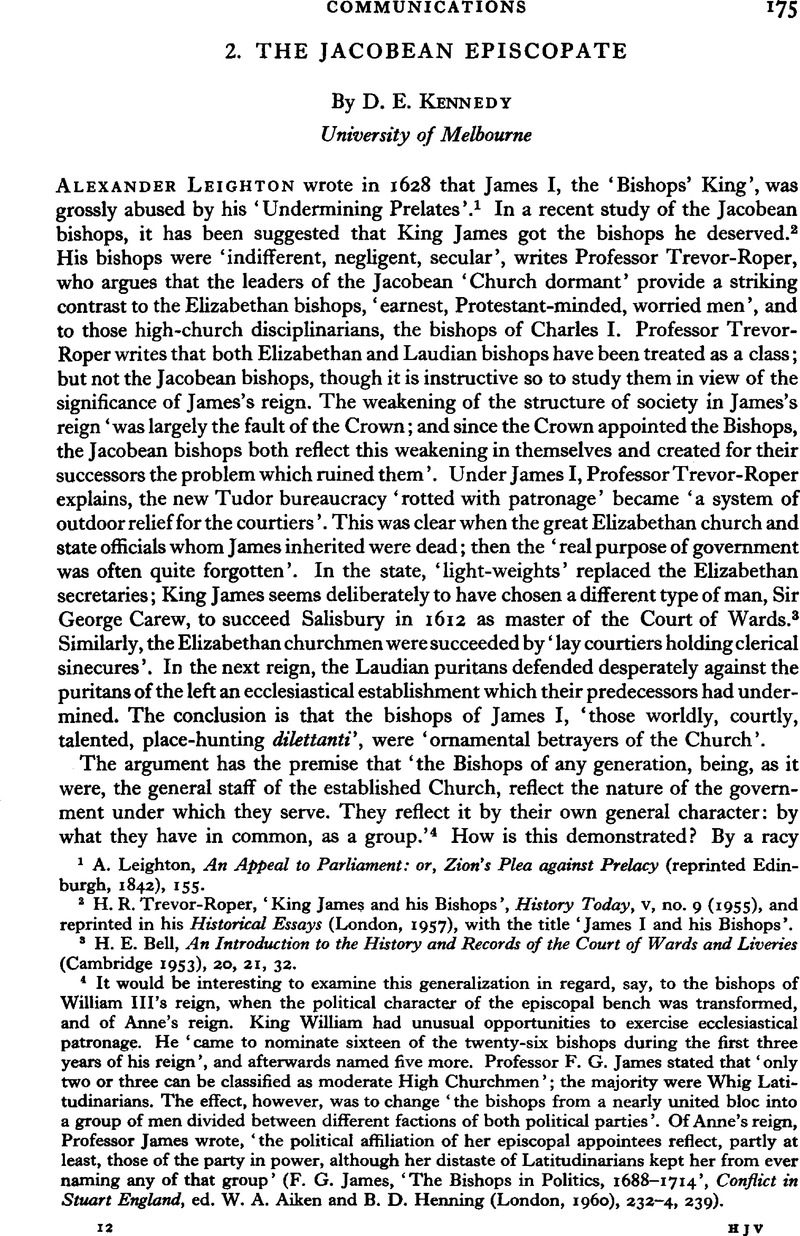Article contents
2. The Jacobean Episcopate
Published online by Cambridge University Press: 11 February 2009
Abstract

- Type
- Communications
- Information
- Copyright
- Copyright © Cambridge University Press 1962
References
1 Leighton, A., An Appeal to Parliament: or, Zion's Plea against Prelacy (reprinted Edinburgh, 1842), 155.Google Scholar
2 Trevor-Roper, H. R., ‘King James and his Bishops’, History Today, v, no. 9 (1955)Google Scholar, and reprinted in his Historical Essays (London, 1957)Google Scholar, with the title ‘James I and his Bishops’.
3 Bell, H. E., An Introduction to the History and Records of the Court of Wards and Liveries (Cambridge 1953), 20, 21, 32.Google Scholar
4 It would be interesting to examine this generalization in regard, say, to the bishops of William III's reign, when the political character of the episcopal bench was transformed, and of Anne's reign. King William had unusual opportunities to exercise ecclesiastical patronage. He ‘came to nominate sixteen of the twenty-six bishops during the first three years of his reign’, and afterwards named five more. Professor F. G. James stated that ‘only two or three can be classified as moderate High Churchmen’; the majority were Whig Latitudinarians. The effect, however, was to change ‘the bishops from a nearly united bloc into a group of men divided between different factions of both political parties’. Of Anne's reign, Professor James wrote, ‘the political affiliation of her episcopal appointees reflect, partly at least, those of the party in power, although her distaste of Latitudinarians kept her from ever naming any of that group’ (James, F. G., ‘The Bishops in Politics, 1688–1714’, Conflict in Stuart England, ed. Aiken, W. A. and Henning, B. D. (London, 1960), 232–4, 239).Google Scholar
5 McClure, N. E. (ed.), The Letters of John Chamberlain, 2 vols. (Philadelphia, 1939), II, 44.Google Scholar
6 Kinloch, T. F., The Life and Works of Joseph Hall, 1574–1656 (London, 1951), 33.Google Scholar For the ‘disparity in the kind of patronage afforded Joseph Hall and John Donne by Sir Robert Drury, within the same decade’, see the Philological Quarterly, xv, no. 4 (1936), 408 ff.Google Scholar
7 Commenting on Williams's sumptuous table and free cellar a modern biographer writes, ‘But the Bishop himself lived temperately, choosing, in advance of his age, a diet drawn mainly from the products of dairy, orchard, and kitchen garden’ (Roberts, B. Dew, Mitre and Musket, London, 1938, p. 121).Google Scholar For an account of life at Buckden see Hacket, J., Scrinia Reserata (London, 1693), II, 29–35.Google Scholar
8 Trevor-Roper, H. R., Archbishop Laud 1573–1645 (London, 1940), 181–2.Google Scholar
9 The context of the quotation is as follows—Montagu wrote about the proceedings against him ‘upon a contempt against the House of Commons’: ‘and as I conceive it my means must be to gett, if it be possible, any, the least, Bishopprique, to take me of from the Commons. Att present I heare the Bishop of Worcester is very sicke. Si quid ei humanitus, if my Lord of S. David's might succede, and I him, I should be half delivered’ (Ornsby, G. (ed.), The Correspondence of John Cosin, part I (Surtees Society, 1869), 77–9).Google Scholar
10 The Works of…William Laud, 7 vols., ed. Scott, W. and Bliss, J. (Oxford, 1847–1860), III, 159.Google Scholar
11 The letter is undated in Cabala sive scrinia sacra (London, 1691)Google Scholar, III, but a reference to ‘my old Master King James’ suggests that it was written after James's death.
12 Trevor-Roper, H. R., Archbishop Laud, 186.Google Scholar
13 Ibid. 187.
14 The Dictionary of National Biography, s.v. Morton, Thomas (1564–1659).
15 Trevor-Roper, H. R., Archbishop Laud, 41.Google Scholar
16 SirD'Ewes, Simonas, The Autobiography and Correspondence, ed. Halliwell, J. O., 2 vols. (London, 1845), 1, 130, 137.Google Scholar
17 Bishops Bridges (Oxford) and Jegon (Norwich) were appointed by James to bishoprics left vacant by Elizabeth.
18 The Letters of John Chamberlain, II, 375.
19 Ibid., I, 561; II, 462.
20 Willson, D. H., King James VI and I (London, 1956), 212.Google Scholar
21 Fuller, T., The Church History of Britain, ed. Brewer, J. S., 6 vols. (Oxford, 1845), VI, 296.Google Scholar
22 The enrichment of his family seems, in the latter part of his life, ‘to have been the principal object of his attention’ (Granger, J., A Biographical History of England, 6 vols., London, 1824, II, 53).Google Scholar
23 For an example of Thornborough's episcopal activity, of which Laud would have approved, see Hill, Christopher, Economic Problems of the Church (Oxford, 1956), 328.Google Scholar
24 Trevor-Roper, H. R., Archbishop Laud, 178–9, 184.Google Scholar
- 1
- Cited by




